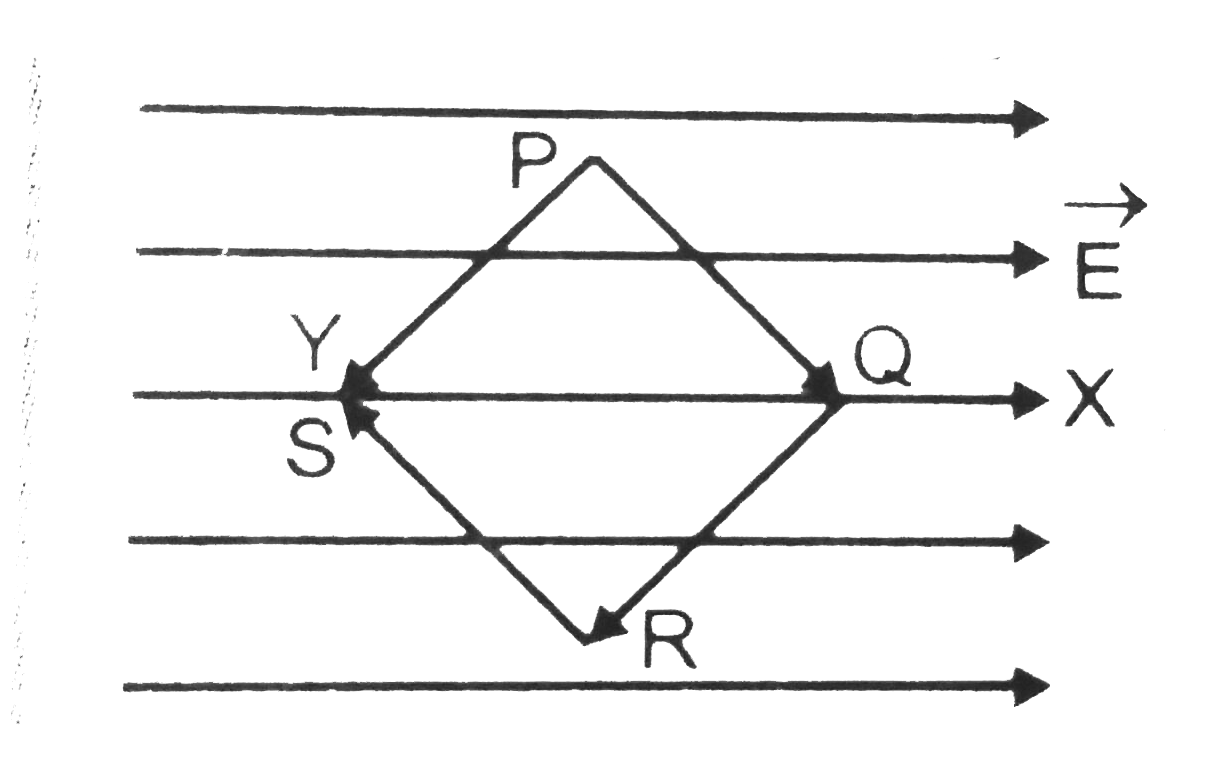A point charge q moves from point P to pont S along the path PQRS (fig.) in a uniform electric field E pointing parallel to the poistive direction of the X-axis. The coordinates of the points P, Q, R and S are(a, b, O), (2a, O, O)(a, -b,O––) and (O, O, O) respectively. The work done by the field in the above process is given by the expresison............

The correct Answer is:−qEa
Here, P(a,b,0),Q(2a,0,0),R(a,−b,0)andS(0,0,0), fig

Effective desplacement is going from P to S via any path is
=−→PS=(0−a)ˆi+(0−b)ˆj+(0−0)ˆk
=−aˆi−bˆj
force on the charge . →F=qEˆi
work done, W=→F.−→PS
=qEˆi.(−aˆi−bˆj)
=−qEa
Negative sign shows that work is done against the electric field by some exteranal agency moving the charge.
Topper's Solved these Questions
- ELECTROSTATICSBOOK - PRADEEPCHAPTER - ELECTROSTATICSEXERCISE - FILL IN THE BLANKS
8 Videos
- ELECTROSTATICSBOOK - PRADEEPCHAPTER - ELECTROSTATICSEXERCISE - PROBLEMS FOR PRACTICE
8 Videos
- ELECTROSTATICSBOOK - PRADEEPCHAPTER - ELECTROSTATICSEXERCISE - VALUE BASED QUESTIONS
7 Videos
- ELECTRONIC DEVICESBOOK - PRADEEPCHAPTER - ELECTRONIC DEVICESEXERCISE - Fill in the Blanks
1 Videos
- MAGNETIC EFFECT OF CURRENT AND MAGNETISMBOOK - PRADEEPCHAPTER - MAGNETIC EFFECT OF CURRENT AND MAGNETISMEXERCISE - Competition Focus (Multiple Choice Questions)
2 Videos
Similar Questions
Knowledge Check
A point charge q moves from A to B along a parabolic(x2 =2ay) path (AB is latus rectum). Electric field is along x-axis. The work done by the field is
A−qEaB+qEaC−2qEaD2qEaA positive point charge q is carried from a point B to a point A in the electric field of a point charge +Q at O. If the permittivity of free space is ε0, the work done in the process is given by (where a=OA and b=OB) -
AqQ4πε0(1a+1b)BqQ4πε0(1a−1b)CqQ4πε0(1a2−1b2)DqQ4πε0(1a2+1b2)ABCD is a parallelogram and O is the point of intersection of its diagonals. If points P, Q, R, S are the mid-points of OA, PB, QC, RD respectively, then the points Q, O, S
Aforms a triangleBare non-coplanarCare collinearDare non-collinear
In an uniform electric field of strength E, a charge particle Q moves point A to point B in the direction of the field and back from B to A. Calculate the ratio of the work done by the electric field in taking the charge particle from A to B and from B to A.
View SolutionCalculate the distance between the point P(O,6)andQ(0,−2).
View SolutionTwo point charges +q and −q are held fixed at (−d,o) and (d,0) respectively of a x-y coordinate system. Then
View SolutionIn the electric field of a point chargde q, a cetrain charge is carried from point A to B,C,D and E. Then the ork done

View SolutionA,B,C are three points on the axis of x, y and z respectively at distance a,b,c from the orgain O, then the co-ordinates of the point which is equidistant from A,B,C and O is
View Solution


